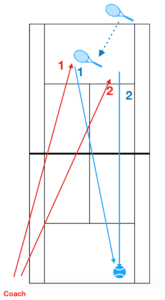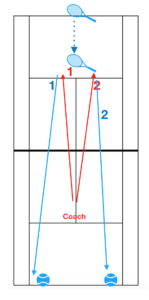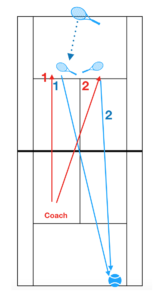Position Opponent to Death: Proactively Attacking Sneak Volley
In a recent blog, when I was sharing about how training in the rain can be fun and productive on different fronts, I mentioned after the hitting in the rain for an hour and a half, I went in doors with my son to work on his aggressive transition game for a couple of hours. This blog describes practical progressions from drills to live ball application you might consider incorporating which is what we did that rainy day. I do this with all levels of players, from 3.5 singles players (men and women) all the way to collegiate players and more, but adjusting for the level of difficulty and accuracy.
So pretend you are on court with me and we are working on being more aggressive, proactively and intentionally looking for opportunities to get in and finish your opponent off. This session is about attacking, the “sneak volley” or what I call “positioning your opponent to death.” The goal is to attack by running in aggressively and hitting a 3/4 court volley or service line volley then closing tight to either finish with a volley to the open court, angle volley or hit a finishing overhead. Very few players have the ability to volley from transition areas, at least at an effective or efficient level. Below are two short clips of ATP and WTA players doing what these progressions help develop. Like always, whether or not you win the point, doing the right thing is the key. Process over product.
Below I will describe various progressions that I run players through in one session so they can work on attacking more comfortably, whether it is outside their comfort zone or they just need to improve a skill already in their arsenal. Then I will describe a game that incorporates, encourages, and rewards this skill set. I had to come up with this game and others as players in general just do not feel comfortable in attacking even at the upper levels.
These progressions are based on the idea that you have just hit a punishing shot to a corner, an angle shot through the sideline getting your opponent off the court, or maybe even a short low ball that puts your opponent at a reach or awkward position, and coming in behind it. The KEY is this. Players need to RECOGNIZE not just that the opponent is out of position (bent over, two hander is reaching with one hand that is weak, or going for a slice that floats etc) but that the ball they just hit will most likely create that scenario. Too often players WAIT & SEE which is code for or ends up being WAIT & TOO LATE. So these progressions help them feel comfortable hitting that first ball in transition in the air.
Progressions 1 & 2
Here the scenario might be the player hits a great shot (like in the video) and the opponent is on the stretch, taking a hand off the two hander and you know it will be a weaker or floating shot so you come running in. So the coach feeds a week shot (slice or chip of sorts) #1 and the pla yer comes flying in and hitting a forehand volley (if right handed, backhand if a lefty) to the open court. I often mix up the height and speed of the ball
yer comes flying in and hitting a forehand volley (if right handed, backhand if a lefty) to the open court. I often mix up the height and speed of the ball . Players need to learn to hit high floaters, low dying balls, etc. From this I work on different footwork patterns depending on the ball and direction it comes at the player. E.g. sometimes it is outside foot for a wide ball and keep moving through the ball. Sometimes if the ball is coming at them a bit then they might have to use carioca, while for other balls it is back to front foot or front to front foot. Also at times it is necessary to work on minimizing the swinging and letting the momentum of the player do the work. Ball 2 in progression #1 is to have the player come in but hit a ball down the line. Again, I mix up the height and speed of the ball so players can work on those variations. In progression #2 I simply reverse the sides from progression #1 and work on the same issues from that side.
. Players need to learn to hit high floaters, low dying balls, etc. From this I work on different footwork patterns depending on the ball and direction it comes at the player. E.g. sometimes it is outside foot for a wide ball and keep moving through the ball. Sometimes if the ball is coming at them a bit then they might have to use carioca, while for other balls it is back to front foot or front to front foot. Also at times it is necessary to work on minimizing the swinging and letting the momentum of the player do the work. Ball 2 in progression #1 is to have the player come in but hit a ball down the line. Again, I mix up the height and speed of the ball so players can work on those variations. In progression #2 I simply reverse the sides from progression #1 and work on the same issues from that side.
Progressions 3-5
Occasionally players hit, intentionally or not, short low balls. Too often the player who hits it stands there and watches like deer in headlights (if you live near deer, you know exactly what that means).
#3 #4 #5


 So these drills create the scenario of a short low ball for the player to follow in and close tightly to hit the volley. Like the prior progressions, I pretend I am scrambling in and reaching for a low ball so the player gets the full effect and closes in. You can also have another player come charging in to get get a ball the coach drops over the net while the net crasher comes in to make the volley off the recovered low ball. In short, that are so many ways to create real situations for match like play.
So these drills create the scenario of a short low ball for the player to follow in and close tightly to hit the volley. Like the prior progressions, I pretend I am scrambling in and reaching for a low ball so the player gets the full effect and closes in. You can also have another player come charging in to get get a ball the coach drops over the net while the net crasher comes in to make the volley off the recovered low ball. In short, that are so many ways to create real situations for match like play.
As you can see from progression 3, the player/coach simulating running up to get a low ball is met by the baseline player who “hit the short ball initially” coming in to net to get the ball at the highest level to make a volley. You can see that balls 1 and 2 or hit to the player so they can practice off both sides. The difficulty in this progression is the angle is not as acute since the ball is coming from the middle. In progressions 4 and 5 the ball is coming from one side which creates more angle or open court.
In all these progressions, once the ball is hit by the coach (or second player) the player working on the volley comes in quickly to pick it off. The coach (or second player) then tries to play out the point or challenge the volleyer once they get the hang of it. This increases the difficulty and makes it even more match like.
An important aspect to transitioning a skill set to real time is the coach making each and every drill resembling and working on actual scenarios that do happen in real time. Being creative is key so take these and adapt them for your player.
Equally important is what I call friendly fire. Too often players, particularly adult USTA players, go from lessons or clinics to playing USTA matches that count or social matches that they deem matter). The problem with this is there is no “intermediate” level of competition to allow yourself to try the new skills without fear of failure. Too often people take a lesson and only play in a setting where they have pressure to win (tournament, or peer match they “have” to win, etc) and they revert to old habits or do not incorporate newly trained skill sets. This is tantamount to waisting your time and money in a lesson. You need friendly fire, a practice game, set, or competition with friends that do not judge, do not hold the “I beat so and so last weak” against you. Let’s face it, for many, tennis has a brutal pecking order system. I usually suggest to people they have friends that are willing to work on things as well and not worry about who wins or loses.
The game below is a perfect such friendly fire opportunity. I developed this game many years ago, and like many games I create or borrow from others, to encourage and reward players to incorporate a skill set. In this case, even most elite college players almost played as if a force field kept them from net. I tell a lot of stories but this one is appropriate for sure. I had a player who was very talented (nationally ranked, great student, etc). He was a quarter finalist of the French Open Junior doubles etc. I video taped his college match one time and brought him into the office (this was before the high tech days–it was mini 8mm tape!). He sat down, I pressed play and he said in his accent “Coach, where am I?” “Exactly,” I said. “You are so far back you couldn’t attack the guy if he paid you.” So this drill is for people like that for sure.
Game of “15-3-2 at Net”
Simply put, a player feeds (or a coach can feed) the first ball up the middle [you can vary this using serves to start the point, feed cross court, feed ball to player on the run etc]. They play out the point and are awarded accordingly:
1 point for everything except
2 points for any shot at or on the way up to net. For example, even if you hit an approach and they miss it you get two points. Putting pressure to pass is part of the idea. Or if you hit a great ball from the baseline (not an approach) and recognize your ball will hurt your opponent and you take off to net to get it in the air you get two points (or even if they miss the passer and you don’t volley, you still get 2 points since you were on your way to net. Maybe they were intimidated by your snorting as you ran to net). THAT IS the entire point of the progression drills described above. If my player does that I am so excited. Yahoo!!.
You play to 15 by 2 points. The key is this. To win the game you HAVE to get to net 3 times and win the point in doing so. So I could be up 15-0 but if I have not gotten to net and won points (worth 2 remember) then I cannot win until I do so, 3 times.
Players behind in score feed the ball so they get first shot to attack (you cannot come in off the feed or the first ball hit).
Score is kept like this: Lets say I feed the ball, my opponent hits it back up the middle and I attack and get in but lose the point. The score is 0-1, 0-0. I lost the point so I have zero and my opponent has 1. We both have NO points won at net so it is 0-0 for that score. Next I feed a ball (because I am behind) and after several shots I approach the net and win the point with a volley. What is the score now?……..
It is 2-1, 1-0. I got 2 points for winning a point at net AND I got 1 of my 3 points needed to be won at net. My opponent now feeds the ball since they are behind.
This is one of my favorite games, players love it and it really does an excellent job in “forcing” players to get to net and often it can be a bit hectic in getting there but sometimes being out of the comfort zone is good.
Let ‘er Rip
Coach